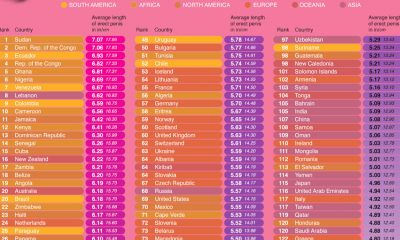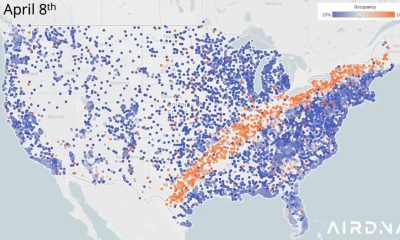Videos
If All the World’s Glaciers Were to Melt, Florida Would Disappear
Did you know that the sea level is rising in Florida, and that it’s costing over $4 billion? In the present day, the sea level surrounding the Sunshine State is up to eight inches higher than it was back in 1950. With more than 120,000 properties at risk in Florida from the frequent tidal flooding, the state is taking action. Florida is currently planning over $4 billion in sea level rise solutions, including that of seawalls, stormwater improvements, protecting sewage systems and raising roads.
[OC] The Lost State of Florida: Worst Case Scenario for Rising Sea Level from r/dataisbeautiful
Created by Jonathan Callura in 2021, this visual uses data from the USGS National Geospatial Program. According to the visual, the global sea level would rise by approximately 70 meters (230 feet) if all of the glaciers on earth were to melt.
According to SeaLevelRise.org, Florida’s sea level has increased over the last decade, and has raised as much as one inch every three years. Because of this, experts are predicting that over the next fifteen years, the sea level in Florida will have risen by another half a foot.
Since 2000, tidal flooding in Florida has increased by approximately 352%, despite the sea level having only risen by an estimated three inches during that time. This is because high tides can lead to flooding, even on the sunniest of days, if the oceans have risen high enough.
“In 30 years Florida will see many more days of flooding, stronger storms, more extreme weather, and stagnant or declining coastal property values.” — Jim Cason, Former Mayor of the City of Coral Gables
Business Visualizations
New Animated Map Shows Airbnb’s Fully Booked Cities Along the 2024 Eclipse Path of Totality
Originally published on 04/04/2024, Updated on 02/20/2025
This year’s solar eclipse is a hot topic. News channels are covering it, everyone is talking about it, and local governments are even warning us about increased traffic in areas near the path of totality. Astronomy geeks and curious tourists alike are flocking to the path of totality to make sure they have the greatest possible viewing experience. While solar eclipses occur between 2 and 5 times per year, it takes nearly 400 years for an eclipse’s path of totality to occur at the same location. In fact, the next time a solar eclipse will be visible from the contiguous United States will be in 2044! So it’s no surprise that this is a big deal to people who live in the area.
Dedicated solar tourists are traveling from all around the country (and even the world) and, as a result, hotels and other accommodations in the area are completely sold out for the days leading up to the April 8th eclipse. AirDNA, a company that provides data analyses and insights on the vacation rental industry, has visualized fully booked Airbnb rentals across the nation for the days leading up to the eclipse and the result is remarkable. Fully booked cities, represented by an orange coloration, perfectly frame the path of totality across the United States. Check out the animated airbnb eclipse map visualization below that was shared by AirDNA’s Chief Economist, Jamie Lane, on Twitter.
Airbnb Eclipse Map:
With the eclipse approaching in less than a week, over half of U.S. cities along the eclipse’s path are fully booked for the night of April 7th according to data from @airdna pic.twitter.com/SLVpyKu2Oe
— Jamie Lane (@Jamie_Lane) April 2, 2024
Why is it so important for people to be directly within the path of 100% totality? Even if you are just barely outside of the path of totality, at 99%, the ambient sunlight is 10,000 times brighter than the eclipse corona, making it impossible to see with the naked eye.
Update 02/20/2025:
We have some new moon-related news for you and I can’t think of a better place to share it than here.
There is a total lunar eclipse coming this March (specifically March 13th going into March 14th). It will be the first lunar eclipse (or “blood moon”) since 2022. A lunar eclipse is different than last year’s solar eclipse in that the Earth will be between the full moon and the sun. It’s often called a blood moon because the moon will appear red during the duration of the eclipse. A solar eclipse (obviously since we just witnessed it here in the U.S.) is when the moon passes in front of the Sun. Next month’s lunar eclipse should be a wonderful sight to see!
Timelines
Animated Timeline Shows Nuclear Warheads by Country Over Time
A nuclear warhead is a highly advanced and meticulously engineered device designed to release an immense amount of energy through nuclear fission or fusion reactions. Comprising fissile materials, triggering mechanisms, and containment structures, it operates by initiating a chain reaction within the atomic nucleus, leading to a catastrophic explosion that far surpasses the destructive power of conventional explosives. The controlled release of nuclear energy in warheads underscores their devastating potential, shaping global security dynamics and emphasizing the critical importance of preventing their use.
[OC] Nuclear Warheads by Country
by u/PieChartPirate in dataisbeautiful
This visualization, as posted by Reddit user PieChartPirate, shows off the nuclear warheads by country, specifically from 1950 through 2022. The visualization was created with SJVisualizer, and the source for the data came from Wikipedia. This is a fascinating look at this information, which by 2022, shows that the worldwide leader in terms of nuclear warheads is Russia with 5,889. Following Russia are the United States (5,244), China (410), France (290), United Kingdom (225), Pakistan (170), India (164), Israel (90), and North Korea (50).
According to the data, if you were to go all the way back to 1951, which is where this visualization starts, only two countries are represented – those being the United States (with 320 at the time) and the Soviet Union (with 7 at the time). Within ten years, more countries were topping the rankings, as by 1961, the United States had 19,381 nuclear warheads, the Soviet Union saw a dramatic jump from 7 to 1,874, the United Kingdom had 65, and France possessed just two.
Timelines
How the Price of a Big Mac Has Changed Around the World (2000-2022)
The iconic Big Mac is a two-beef patty, three bun delicacy topped with iceberg lettuce, American cheese, pickles, chopped onions and the super secret Mac Sauce. In 1968, it was so popular with its limited release in Pennsylvania that it was rolled out to every McDonald’s restaurant across the United States. That popularity never waned and there is now an entire economic phenomenon known as ‘burgernomics’ modeled from the Big Mac. Economists will use the price of the big mac as a way to gauge inflation rates and economics across globe. Today the Big Mac is up 40% from 2010. We can see in this video visualization by /u/jcceagle that follows the price of a Big Mac over the last 20 years, just how different cost can be across the globe and over time.
In the year 2000 Norway had the most expensive Big Mac for $4.09, while in the Philippines it cost $1.17. Eight years later, Norway still tops the charts with the most expensive Big Mac but instead of just over four dollars, it increased to $7.88. At that time in the US a Big Mac cost $3.57 while the cheapest was found in Malaysia for $1.70 and the Philippines increased to $1.96. In July 2017 the most expensive Big Mac was down across the board from 2008 to $6.74 in Switzerland. That same year a Big Mac in the US would have cost you $5.30 and $1.70 in the Ukraine. The video also shows an index of currency valued relative to the US dollar where you can see the values changes across the different currency around the world.
-

 Business Visualizations1 year ago
Business Visualizations1 year agoEverything Owned by Apple
-

 Business Visualizations1 year ago
Business Visualizations1 year agoAmerica’s Most Valuable Companies Ranked by Profit per Employee
-

 Business Visualizations10 months ago
Business Visualizations10 months agoThe Biggest Fortune 500 Company in Every State
-

 Business Visualizations7 months ago
Business Visualizations7 months agoThe Biggest Employers by Industry
-

 Maps2 years ago
Maps2 years agoPenis Lengths Around the World
-

 Business Visualizations2 years ago
Business Visualizations2 years agoAll The Brands Owned By PepsiCo
-

 Timelines2 years ago
Timelines2 years agoA History of the Oldest Flags in the World
-

 Business Visualizations2 years ago
Business Visualizations2 years agoNew Animated Map Shows Airbnb’s Fully Booked Cities Along the 2024 Eclipse Path of Totality
